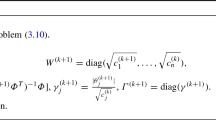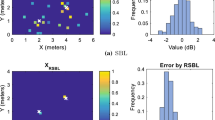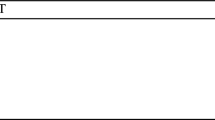Abstract
The least absolute shrinkage and selection operator (LASSO) and its variants are widely used for sparse signal recovery. However, the determination of the regularization factor requires cross-validation strategy, which may obtain a sub-optimal solution. Motivated by the self-regularization nature of sparse Bayesian learning (SBL) approach and the framework of generalized LASSO, we propose a new hierarchical Bayesian model using automatic-weighting Laplace priors in this paper. In the proposed hierarchical Bayesian model, the posterior distributions of all the parameters can be approximated using variational Bayesian inference, resulting in closed-form solutions for all parameters updating. Moreover, the space alternating variational estimation strategy is used to avoid matrix inversion, and a fast algorithm (SAVE-WLap-SBL) is proposed. Comparing to existed SBL methods, the proposed method encourages the sparsity of signals more efficiently. Numerical experiments on synthetic and real data illustrate the benefit of these advances.











Similar content being viewed by others
Data availability
The datasets generated during and/or analyzed during the current study are available from the corresponding author on reasonable request.
Notes
‘Under-sampled’ means that \(M<N\) in Eq. (1).
In this paper, the \(l_0\) norm is defined as the number of non-zero elements of signal \(\varvec{\beta }\).
References
Al-Shoukairi M, Schniter P, Rao BD (2018) A GAMP-based low complexity sparse Bayesian learning algorithm. IEEE Trans Signal Process 66(2):294–308
Babacan S, Molina R, Katsaggelos A (2010) Bayesian compressive sensing using Laplace priors. IEEE Trans Image Process 19(1):53–63
Bai Z, Jensen JR, Sun J, Christensen MG (2019) A sparse Bayesian learning based RIR reconstruction method for acoustic TOA and DOA estimation. In: 2019 IEEE Workshop on Applications of Signal Processing to Audio and Acoustics (WASPAA). IEEE, New York, USA
Bai Z, Sun J, Jensen JR, Christensen MG (2019) Indoor sound source localization based on sparse Bayesian learning and compressed data. In: 2019 27th European signal processing conference (EUSIPCO). IEEE, A Coruna, Spain
Bajwa WU, Duarte MF, Calderbank R (2015) Conditioning of random block subdictionaries with applications to block-sparse recovery and regression. IEEE Trans Inf Theory 61(7):4060–4079. https://doi.org/10.1109/TIT.2015.2429632
Baraniuk RG, Cevher V, Duarte MF, Hegde C (2010) Model-based compressive sensing. IEEE Trans Inf Theory 56(4):1982–2001. https://doi.org/10.1109/TIT.2010.2040894
Carvalho CM, Polson NG, Scott JG (2009) Handling sparsity via the horseshoe. In: Proceedings of the twelth international conference on artificial intelligence and statistics, proceedings of machine learning research, vol. 5, pp. 73–80. PMLR
Chen PY, Selesnick IW (2014) Group-sparse signal denoising: Non-convex regularization, convex optimization. IEEE Trans Signal Process 62(13):3464–3478. https://doi.org/10.1109/TSP.2014.2329274
Cotter S, Rao B, Engan K, Kreutz-Delgado K (2005) Sparse solutions to linear inverse problems with multiple measurement vectors. IEEE Trans Signal Process 53(7):2477–2488. https://doi.org/10.1109/tsp.2005.849172
Dai W, Milenkovic O (2009) Subspace pursuit for compressive sensing signal reconstruction. IEEE Trans Inf Theory 55(5):2230–2249. https://doi.org/10.1109/tit.2009.2016006
DiBiase JH, Silverman HF, Brandstein MS (2001) Robust localization in reverberant rooms. Springer Berlin Heidelberg, Berlin, Heidelberg, pp 157–180
Donoho DL (2006) Compressed sensing. IEEE Trans Inf Theory 52(4):1289–1306. https://doi.org/10.1109/TIT.2006.871582
Fang J, Shen Y, Li H, Wang P (2015) Pattern-coupled sparse Bayesian learning for recovery of block-sparse signals. IEEE Trans Signal Process 63(2):360–372. https://doi.org/10.1109/TSP.2014.2375133
Fang J, Wang F, Shen Y, Li H, Blum RS (2016) Super-resolution compressed sensing for line spectral estimation: an iterative reweighted approach. IEEE Trans Signal Process 64(18):4649–4662
Fortunati S, Grasso R, Gini F, Greco MS, LePage K (2014) Single-snapshot DOA estimation by using compressed sensing. EURASIP J Adv Signal Process 2014(1):1–17
Gerstoft P, Mecklenbrauker CF, Xenaki A, Nannuru S (2016) Multisnapshot sparse Bayesian learning for DOA. IEEE Signal Process Lett 23(10):1469–1473
Gorodnitsky I, Rao B (1997) Sparse signal reconstruction from limited data using FOCUSS: a re-weighted minimum norm algorithm. IEEE Trans Signal Process 45(3):600–616
Govinda Raj A, McClellan JH (2019) Single snapshot super-resolution DOA estimation for arbitrary array geometries. IEEE Signal Process Lett 26(1):119–123
Li D, Yin Q, Mu P, Guo W (2011) Robust mvdr beamforming using the DOA matrix decomposition. In: 2011 1st International symposium on access spaces (ISAS), vol. 1, pp. 105–110. https://doi.org/10.1109/ISAS.2011.5960929
Liu S, Huang Y, Wu H, Tan C, Jia J (2021) Efficient multitask structure-aware sparse Bayesian learning for frequency-difference electrical impedance tomography. IEEE Trans Industr Inf 17(1):463–472
Liu ZM, Huang ZT, Zhou YY (2012) An efficient maximum likelihood method for Direction-of-Arrival estimation via sparse Bayesian learning. IEEE Trans Wirel Commun 11(10):1–11
Löllmann HW, Evers C, Schmidt A, Mellmann H, Barfuss H, Naylor PA, Kellermann W (2018) The LOCATA challenge data corpus for acoustic source localization and tracking. In: 2018 IEEE 10th Sensor array and multichannel signal processing workshop (SAM), pp. 410–414
Makalic E, Schmidt DF (2016) A simple sampler for the horseshoe estimator. IEEE Signal Process Lett 23(1):179–182. https://doi.org/10.1109/LSP.2015.2503725
Malioutov D, Cetin M, Willsky A (2005) A sparse signal reconstruction perspective for source localization with sensor arrays. IEEE Trans Signal Process 53(8):3010–3022
Thomas CK, Slock D (2018) SAVE - space alternating variational estimation for sparse Bayesian learning. In: 2018 IEEE Data science workshop (DSW). IEEE
Tibshirani R (1996) Regression shrinkage and selection via the LASSO. J Roy Stat Soc: Ser B (Methodol) 58(1):267–288. https://doi.org/10.1111/j.2517-6161.1996.tb02080.x
Tibshirani RJ, Taylor J (2011) The solution path of the generalized LASSO. Ann Stat 39(3):1335–1371
Tipping ME, Faul A, Avenue JJT, Avenue JJT (2003) Fast marginal likelihood maximisation for sparse Bayesian models. In: Proceedings of the ninth international workshop on artificial intelligence and statistics, pp. 3–6
Tipping ME, Smola A (2001) Sparse Bayesian learning and the relevance vector machine. J Mach Learn Res 59(1):211–244
Tzikas DG, Likas AC, Galatsanos NP (2008) The variational approximation for Bayesian inference. IEEE Signal Process Mag 25(6):131–146. https://doi.org/10.1109/msp.2008.929620
Wipf DP, Rao BD (2007) An empirical Bayesian strategy for solving the simultaneous sparse approximation problem. IEEE Trans Signal Process 55(7):3704–3716
Xenaki A, Boldt JB, Christensen MG (2018) Sound source localization and speech enhancement with sparse Bayesian learning beamforming. J Acoust Soc Am 143(6):3912–3921
Yang J, Yang Y (2020) Sparse Bayesian DOA estimation using hierarchical synthesis lasso priors for off-grid signals. IEEE Trans Signal Process 68:872–884
Yang Z, Li J, Stoica P, Xie L (2018) Chapter 11 - sparse methods for direction-of-arrival estimation. In: Chellappa R, Theodoridis S (eds) Academic Press library in signal processing. Academic Press, Cambridge, pp 509–581
Zhang Z, Rao BD (2011) Sparse signal recovery with temporally correlated source vectors using sparse Bayesian learning. IEEE J Select Topics Signal Process 5(5):912–926
Zheng R, Xu X, Ye Z, Dai J (2020) Robust sparse Bayesian learning for DOA estimation in impulsive noise environments. Signal Process 171:107500
Zheng Y, Fraysse A, Rodet T (2015) Efficient variational Bayesian approximation method based on subspace optimization. IEEE Trans Image Process 24(2):681–693
Zou H (2006) The adaptive LASSO and its oracle properties. J Am Stat Assoc 101(476):1418–1429
Author information
Authors and Affiliations
Contributions
ZB conceptualized the study and run the experiments. JS edited the manuscript. All the authors read and approved the final manuscript.
Corresponding author
Ethics declarations
Conflict of interest
The authors declare that they have no competing interests.
Additional information
Publisher's Note
Springer Nature remains neutral with regard to jurisdictional claims in published maps and institutional affiliations.
Rights and permissions
Springer Nature or its licensor (e.g. a society or other partner) holds exclusive rights to this article under a publishing agreement with the author(s) or other rightsholder(s); author self-archiving of the accepted manuscript version of this article is solely governed by the terms of such publishing agreement and applicable law.
About this article
Cite this article
Bai, Z., Sun, J. Sparse Bayesian learning with automatic-weighting Laplace priors for sparse signal recovery. Comput Stat 38, 2053–2074 (2023). https://doi.org/10.1007/s00180-023-01354-4
Received:
Accepted:
Published:
Issue Date:
DOI: https://doi.org/10.1007/s00180-023-01354-4




